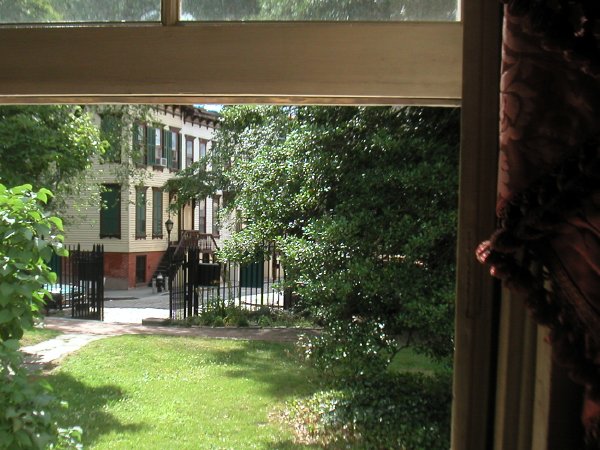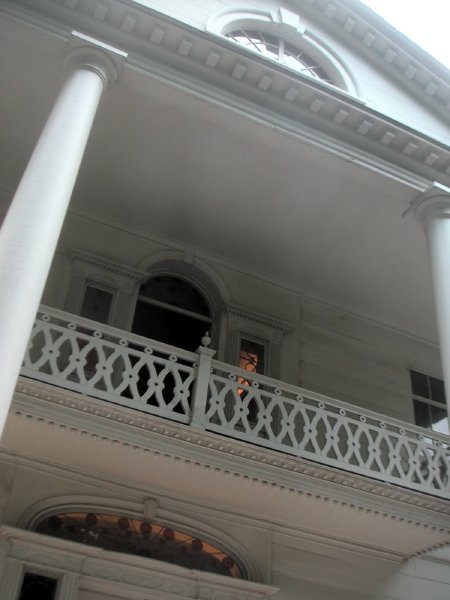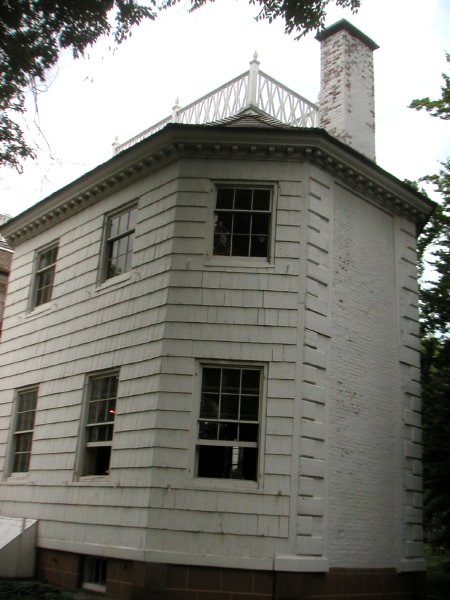
view of the eastern end of Sylvan Terrace through a window of the octagon drawing room inside the Morris-Jumel Mansion
George Washington slept there.
A 1765 wooden American Paladian villa sitting in upper Manhattan on a rise which originally commanded both the Harlem Valley to the east, the Hudson River to the west and New York City some ten miles south, the Morris-Jumel Mansion (actually a country summer home) still offers its considerable pleasures to visitors. Today that means both the community immediately surrounding it and a much larger world beyond; two hundred years ago it regularly meant most of the founders of our republic.
Barry and I visited the house which for most of the nineteenth century belonged to the amazing Madame Eliza Bowen Jumel both out of curiosity about the place and for the attraction of an interesting program of eighteenth and nineteenth century English and German art song presented in the kind of space for which it was composed. It was a concert which could well have been enjoyed by this woman's own guests in that same room over 150 years ago.
On Saturday afternoon we sat in the drawing room below Washington's quarters, listening to songs in English by Haydn and some of his more obscure contemporaries. After an intermission we returned for two lieder cycles by a similarly-neglected Franz Lachner. Birds sang and could easily be seen playing in the trees outside the open windows decorated with red silk hangings.
The performance by the wonderful tenor Rufus Müller and Donsok Shin, his accompanist at the fortepiano, was artistry of the highest order, and would have been an enormous sensual pleasure even without the extraordinary peace and beauty of the venue. Some three dozen guests seated themselves in the octagon drawing room of Madame Jumel's chateau, the walls covered in a painted Chinese wallpaper of flowers and birds on a deep blue ground. We sat in a magic pagoda cooled by large beech and horse chestnut trees standing in what remains of an estate which once covered 130 acres across the width of the island.
After the performance we joined the museum hosts and the two artists for refreshments upstairs in the large central hall which runs behind the front balcony. A huge portrait of the redoubtable dowager Madame Jumel was very much a part of our company.
These intelligently-programmed concerts are scheduled regularly by Music at Morris-Jumel, and we're on the mailing list. Because of its delightfully small scale however, it's hard to imagine how this wonderful series of chamber music performances will survive in this city of mammon. I hope I'm wrong.
NOTE: I can't let this story go without lamenting that no one has yet written a satisfactory biography of the remarkable woman who became Madame Eliza Jumel. I wasn't even able to find an adequate account to link to for the purpose of this post, but the National Park service offers a tease:
The stately two-story Morris-Jumel mansion, built in 1765 in a Georgian style modified to suit a country setting, was purchased by Mr. and Mrs. Stephen Jumel in 1810. Though Stephen Jumel was a former Caribbean plantation owner and successful wine merchant, it was the colorful and controversial Madam Eliza Jumel who became the talk of New York City society. Eliza Jumel's life typified the limited options of ambitious young women born into poverty in late 18th-century America. Forced into prostitution early in life as a means of survival, Eliza's fortune turned after meeting and marrying Stephen Jumel in 1804. The prejudices of society against those with such a background forbade any acceptance of Mrs. Jumel. Wealth permitted travel, however, and the Jumels sailed to France in 1815. There, Eliza found social acceptance, mingling with aristocrats while adopting openly Bonapartist sympathies. Such convictions, voiced soon after Napoleon's exile, proved too controversial for the new French government, and in 1816 Louis XVIII ordered Mrs. Jumel to leave France. Eliza returned to the mansion, but her marriage was soon in decline over Stephen's discovery of her early life and the dwindling Jumel fortune. While Stephen remained in France, Eliza sold business holdings and kept the profits, pursuing social acceptance through wealth while leaving Stephen penniless and hastening his death. Fourteen months later Eliza, then 58, married 77 year-old, former Vice-President Aaron Burr. The marriage was marked by Burr's misuse of the Jumel fortune and the two were formally divorced on September 14, 1836, the day of Burr's death. Jumel spent the rest of her life in the mansion, dying here in 1865 at the age of 90.

a grand two-story portico protects a small second story balcony at the front of the house

the octagonal drawing room and an upstairs chamber and cabinets is almost a separate garden folly, as it is attached to the rear of the house only at the short plane of one of its narrow ends.
Did Mme. Jumel ever live in a home in New York City? For a time I resided in an apartment building on Anderson Avenue, the Bronx, on a hill above Yankee Stadium. There was a marker relating to Aaron Burr. I have a book,published 1935, by William Cary Duncan, THE AMAZING MADAME JUMEL. The book contains references to the travails of Jonathan and Phebe, and recounts their brief stay in Williamton (Williamston), NC in about 1798. In Williamston, NC there are residents who know the story. I's a fascinating story. Has anyone done a play or a film about this amazing Madame Jumel?
There is a fabulous chapter on Madame Jumel in a book that has been republished but based on original 1917 articles written for Ainslee's Magazine. The book's title is "Famous Hussies of History: Stories of the Super-Women." I am *not* making this up! :)
For another perspective on the life of Eliza Jumel, read the 1963 biographical novel, "Madame Jumel", by pauline Panzer.
I am a decendent of Madam Jumel, I find all these stories facinating and some of them hard to believe. I would love to find out more about the life of Madam Jumel. It would be great to have a movie about her life. Thanks for your site.
Madame Jumel may have been connected through Aaron Burr to a Margaret Blennerhasset..her husband was tried for treason with Burr. Margaret died destitute near Burr's law office in NYC. She was supported by a subscription from New York society and buried is a borrowed grave. I would love to know if the madame helped her out.
Where I grew up, on Charnock Hill Road in Rutland, Massachusetts, there was a hand-lettered sign near an old country cemetery where most of the graves dated back to the 1700 and early 1800's. The sign, long gone now, for I am a grown woman in my late fifties and only recently drove back down that old country road again, said "nearby stood the home of Madame Jumel, Mistress of Aaron Burr." From what reading I've done, some accounts have her being raised in a "shanty" in Rutland, Mass., and others speak of her adoption by a Rhode Island family. Any further information on this would be of great interest to me.
Thanks -
Where I grew up, on Charnock Hill Road in Rutland, Massachusetts, there was a hand-lettered sign near an old country cemetery where most of the graves dated back to the 1700 and early 1800's. The sign, long gone now, for I am a grown woman in my late fifties and only recently drove back down that old country road again, said "nearby stood the home of Madame Jumel, Mistress of Aaron Burr." From what reading I've done, some accounts have her being raised in a "shanty" in Rutland, Mass., and others speak of her adoption by a Rhode Island family. Any further information on this would be of great interest to me.
Thanks -
Where I grew up, on Charnock Hill Road in Rutland, Massachusetts, there was a hand-lettered sign near an old country cemetery where most of the graves dated back to the 1700 and early 1800's. The sign, long gone now, for I am a grown woman in my late fifties and only recently drove back down that old country road again, said "nearby stood the home of Madame Jumel, Mistress of Aaron Burr." From what reading I've done, some accounts have her being raised in a "shanty" in Rutland, Mass., and others speak of her adoption by a Rhode Island family. Any further information on this would be of great interest to me.
Thanks -
I've read a book written about Madam Jumel called "Madame of the Heights" ["Madame of the Heights: The story of a prostitute's progress" is the full title - Ed.]. At the time I had already read "Jefferson", and started to read "Burr". Was a very interesting read for me as all three books were about the same era and people.
Also: "Painted Lady: Eliza Jumel Her Life and Times" Leonard Falkner, E P Dutton, NY, 1962. Includes her decision early in life not to follow her mother's career of assignation.
In 1938 a musical based on the rags-to-riches life of Madame Jumel opened on Broadway.
Produced by Dwight Deere Wiman [heir to the John Deer tractor fortune and the producer of "Kiss Me, Kate"] and J.H. Del Bondio, GREAT LADY, was an early work by Frederick Loewe and his first collaborator, Earle Crooker.
It starred three great ladies of the musical stage: Norma Terris [the original Magnolia in Show Boat], Irene Bordoni [from Cole Porter's Paris and Irving Berlin's Louisana Purchase] and Helen Ford [Rodgers and Hart's Dearest Enemy].
A number of artists who would gain fame later in life appeared in the show's chorus of singers and dancers: opera singer Dorothy Kirsten, ballet dancer Andre Eglefsky, and Jerome Robbins.
Introduced uncomfortably by a scene set in modern times, GREAT LADY was doctored on the road by other script writers. Unfortunately, the jokey and crass revisions only made the script worse.
The show closed on Broadway after 20 performances.
Despite this, many of the songs had a charm and elan that the script, except for a few good scenes, mostly lacked. When you hear the melodies played, one can't help wondering if there'd be any place for the show now. Perhaps, with a new book, it could work as a school's piece for young audiances.
My mother, who died in 1997, owned a baroque gold-leaf mirror that once hung in Madam Jumel's Circular Street home in Saratoga. For some reason, she always insisted that we were related to Madam Jumel, but I have not been able to trace this. My brother has the mirror and it is quite glorious! i am using Madam Jumel as the subject of an historic poem for a project I am working on.